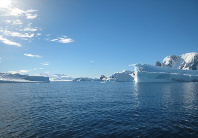Arctic ocean
The Atlantic Ocean is the world’s second largest ocean, behind the Pacific Ocean. With a total area of about 106,400,000 square kilometres (41,100,000 sq mi), it covers approximately 20 percent of the Earth’s surface and about 29 percent of its water surface area. The first part of its name refers to Atlas of Greek mythology, making the Atlantic the “Sea of Atlas”.
Atlantic ocean
The Arctic Ocean, located in the Northern Hemisphere and mostly in the Arctic north polar region, is the smallest and shallowest of the world’s five major oceanic divisions. The International Hydrographic Organization (IHO) recognizes it as an ocean, although some oceanographers call it the Arctic Mediterranean Sea or simply the Arctic Sea, classifying it a mediterranean sea or an estuary of the Atlantic Ocean. Alternatively, the Arctic Ocean can be seen as the northernmost part of the all-encompassing World Ocean.
Indian ocean
The Indian Ocean is the third largest of the world’s oceanic divisions, covering approximately 20% of the water on the Earth’s surface. It is bounded by Asia—including India, after which the ocean is named on the north, on the west by Africa, on the east by Australia, and on the south by the Southern Ocean (or, depending on definition, by Antarctica).
Pacific ocean
The Pacific Ocean is the largest of the Earth’s oceanic divisions. It extends from the Arctic in the north to the Southern Ocean (or, depending on definition, to Antarctica) in the south, bounded by Asia and Australia in the west, and the Americas in the east.
Southern ocean
The Southern Ocean (also known as the Great Southern Ocean, Antarctic Ocean, South Polar Ocean and Austral Ocean) comprises the southernmost waters of the World Ocean, generally taken to be south of 60°S latitude and encircling Antarctica. As such, it is regarded as the fourth-largest of the five principal oceanic divisions (after the Pacific, Atlantic, and Indian Oceans, but larger than the Arctic Ocean). This ocean zone is where cold, northward flowing waters from the Antarctic mix with warmer subantarctic waters.





